This aquarium-favorite snail is named for its characteristic zebra stripes pattern that adorns its body. The snail has a simple but impressive beauty that makes everybody want to have them in their aquarium. Before you get into the scramble to own the snail, it is important to note that they are voracious algae-eating animals.
If you are in for an animal you would like to have in your aquarium to eat away those unsightly algae in your glass aquarium, then the Zebra Snail might be your best bet. These freshwater snails will help clean the substrate in your aquarium by keeping the substrate free of algae because they eat them.
The snails are hardy and therefore may not require lots of attention, thus making their maintenance quite manageable and easy. They are an ideal option for beginning snail aquarists owing to the minimal maintenance requirements. The snails are native to Africa and were originally sourced from Kenya, Tanzania, South Africa, and Mozambique. Unlike most other snails that are hermaphroditic, the zebra snail has a male and female.
Table of Contents
Zebra Snail: A Brief Introduction
Zebra snails are small, striped freshwater snails from Southeast Asia. They are popular in the aquarium trade for their attractive appearance and algae-eating habits. They require a secure tank lid, a diet of algae, vegetables, and snail pellets, and are generally peaceful and easy to care for.
Zebra Snail Overview
Zebra snails have striking black stripes, making them one of the most beautiful freshwater snails. Due to their uniqueness, aquarists keep them to decorate the tank. And the fact that they like feeding on algae makes them even easy to maintain.
While zebra snails like eating algae, they do not feed on plants. That means you can place them in a heavily planted tank without worry.
While housing zebra snails, remember that they have a reputation for climbing up and above the water level. Thus, keeping them in a tank with a tight-fitting lid or cover glass is important. It will keep them from escaping.
If you are ready to keep a zebra snail in your tank, read the below information.
| Information chart | Zebra snail |
|---|---|
| Scientific name | Neritina natalensis |
| Family | Neritidae |
| Care level | Moderate |
| Temperament | Peaceful and shy |
| Color | Golden-brown |
| Lifespan | 2 years |
| Size | 1 inches |
| Diet | Algae |
| Minimum tank size | 20 gallons |
| Temperature | 72-78 °F |
| Water conditions | 8.1–8.4 pH |
| Tank mate compatibility | Barbs, neon tetra, kuhli loaches, and more. |
The Appearance of Zebra Snail
The snail features a characteristic black and golden stripe pattern similar to the zebra stripes. The amazing elegance and beauty of the snails make them the most sought aquatic snail in the hobby. The snail is rather small in size, and the average body size is usually about one inch or even smaller, especially those that are kept in captivity.

Zebra Snail Shell Design and Color
Zebra snails belong to the Neritidae family and like to live in freshwater. They have attractive shells with gold and dark brown stripes.
Some zebra snails have thin stripes, which look like pinstripes. At the same time, others have a thicker strip that appears on the shell irregularly. Also, some zebra snails have rows of spots rather than full stripes.
It doesn’t matter what pattern zebra snail you pick. It will look stunning and make your tank even more attractive.
The Lifespan of Zebra Snail
The typical lifespan of a zebra snail is believed to be two years. But certain snails are known to live only for a year.
If you want your snail to live long, it’s important to offer better care, diet, and environment. Also, you must regularly check for diseases.
Zebra Snail Size
Zebra snails are usually sold when they are ⅓~½” in diameter. But they can grow up to one inch if given proper care, diet, and love.
Natural Habitat and Origin
The snail is known to live in freshwater but can also survive in saltwater. The native natural habitat range of the snail includes Kenya, Tanzania, South Africa, Somali, and Mozambique. The snail is most commonly found in small water bodies, including streams, rivers, and ponds.
The snail spends most of its time in freshwaters, but when it is time for breeding, it goes to brackish waters where it does the breeding. It is an important aspect of the snail that you need to learn if you want to breed them at home.
Zebra Snail Care and Tank Set-Up
Before you keep a zebra snail, it’s important to know that they have a habit of crawling out of their tank and walking on a walkabout.
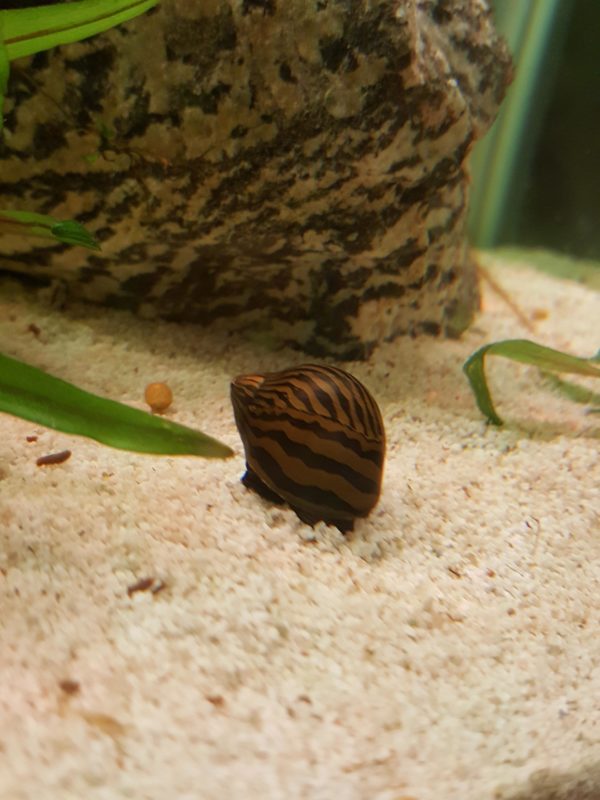
You must keep them tightly in a tank. If zebra snails escape, they can survive for a couple of hours. But eventually, the snails will die as they will dry out.
While keeping them in a tank, you should always provide them with plenty of hiding places where they can retreat when they feel stressed. Having multiple hiding spots is that they won’t have to travel long to take a nap.
Even though the Zebra Snail is a freshwater inhabitant, it also can survive in saltwater. It is known to move to brackish waters it is ready to breed. The snail has become a favorite for so many aquarists who choose it for its amazing coloration and patterns on its body.
Others also like it because it helps to keep things clean in an aquarium setting by eating algae. To get up close with the ideal tank parameters for keeping the Zebra Snail, read the following tips:
Tank Size and Specification
Optimum Tank Size for Zebra Snail
The recommended tank size for zebra snails is 20 gallons. A tank smaller than this would not be fit for the snail.
Tank Shape for Zebra Snail
You can have a rectangular tank for your zebra snail.
Filter Type
You must keep the tank water clean by adding a powerful filter type. But you should put a cover on the intake valve of any filter. Not doing so can even kill the snail because they can be sucked inside.
Substrate
For your zebra snail, you can choose fine-grained sand. Avoid adding anything rocky as snails have delicate tentacles that can get damaged.
How Many Zebra Snails in 20 Gallons of Water?
A 20 gallons tank can accommodate up to 4 zebra snails.
Water Parameter for Zebra Snail
In this section, we will discuss the pH level, water hardness, and water temperature.
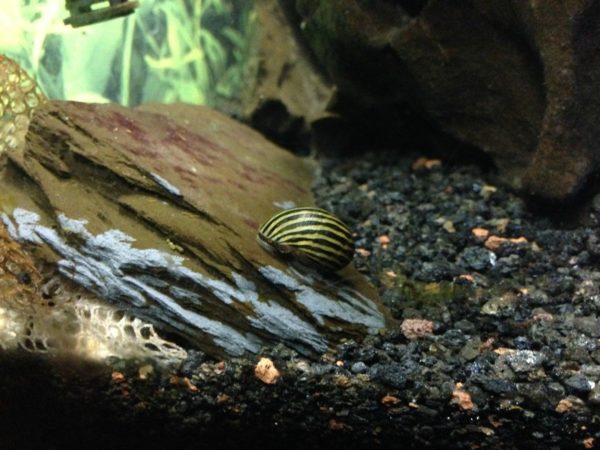
Water Temperature
The ideal water temperature for zebra snails is 72-78 °F.
pH Level
The pH level should be between 8.1 to 8.4.
Water Hardness
The hardness of the tank water for zebra snails should be around 6-12dH.
Zebra Snail Landscape
To set up a home for your zebra snail, you need a 20 gallons tank. In the tank, you can add up to 4 zebra snails. Make sure that the temperature and pH level is balanced. And for the substrate, choose fine-grained sand.
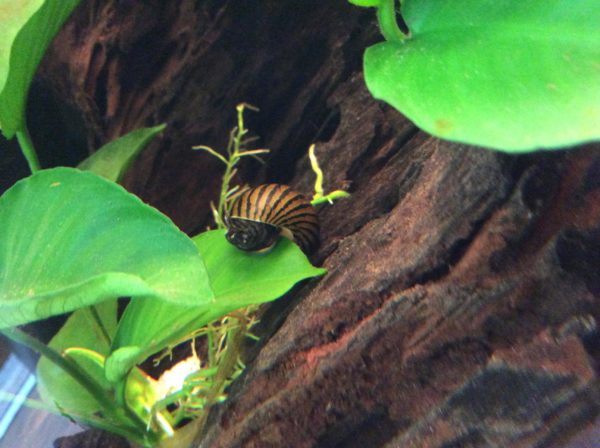
Best Plants for Zebra Snail Tanks
The algae-loving zebra snail likes greenery in its diet. But it will not feed on plants. It offers tank keepers a great opportunity to add multiple plants to their zebra snail tank.
Ensure that the plant you choose does not cover the water surface as it might stop lighting entering the tank.
Worst Plants for Zebra Snail Tanks
The good news is that you can add any type of plant to the zebra snail tank. But avoid adding any plants that can increase the water’s nitrate level.
Decorations for Zebra Snail Tanks
It’s recommended to add driftwood, live plants, and similar decorations.
Lighting for Zebra Snail Tanks
Zebra snails does not have any special requirements for lighting.
Nitrate Requirement for Zebra Snail
You should keep nitrate levels at a minimum because these snails will not tolerate high nitrate levels in the water.
Because the snails are highly allergic to copper, it is best to check for any copper traces in the tank water before introducing the snail there. Also, ensure that you supplement the animals with sufficient calcium levels, as this will help the snails maintain the health of their shells. You can do this by feeding animal foods rich in calcium, such as spinach, green kales, additives, and any other green plants rich in the mineral.
Feeding Zebra Snail
Best Diet for Zebra Snail
The Zebra Snails are primarily herbivores that feed exclusively on plant matter, preferring to eat algae. Some aquarists will rear these snails to help eat up the algae inside their aquariums to keep things clear there!
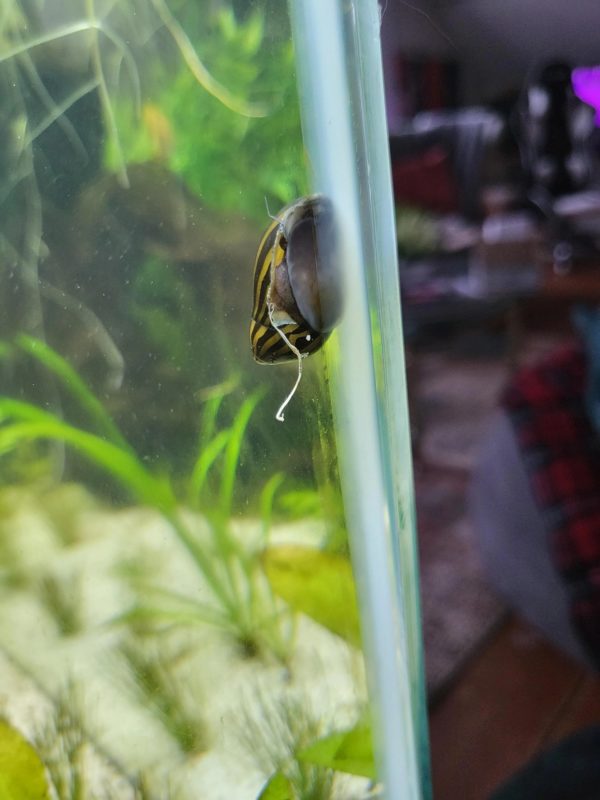
Apart from algae which form the primary diet, they can be fed other plant food such as spinach, kales, carrots, zucchini, etc.
If the tank does not have any leftover algae, you can feed it an algae wafer. But do not add more water because if the snail does not eat them, it will contaminate the tank water.
How Often Should You Feed Zebra Snails?
If the tank has plenty of algae, you do not have to worry about feeding these little guys. But if the tank is clean, feed them daily.
Zebra Snail Behavior and Temperament
Generally, zebra snails are peaceful and enjoy spending their time without bothering anyone. They only like to munch algae and rest.
Are Zebra Snail Lone or Societal
Zebra snails don’t get lonely. But they don’t mind sharing the tank with compatible fish. Also, they are known for ignoring their kind unless they want to breed.
Tank Mates for Zebra Snail
Zebra snails are perfect examples of non-aggressive creatures. They can happily live with calm and friendly fish. But avoid housing them with fish species that are large and aggressive.
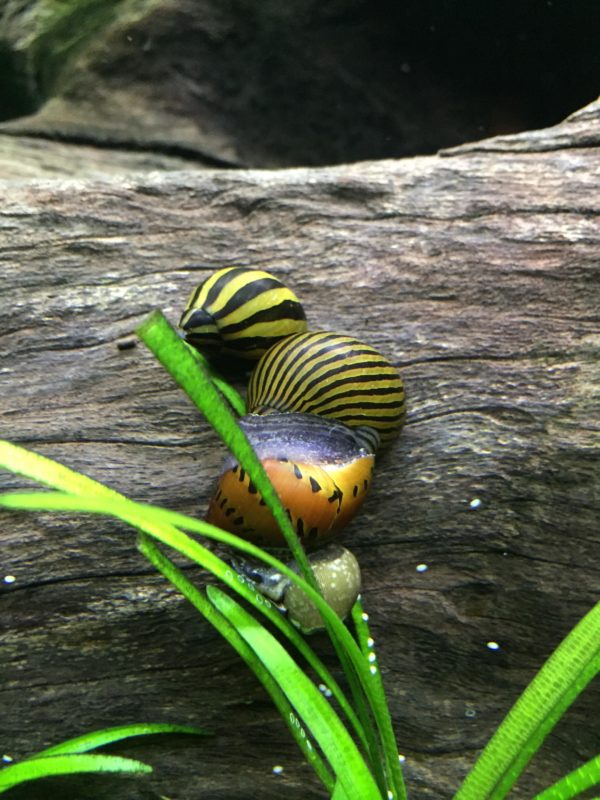
The snails are usually peaceful and will easily blend in the same environment with other peaceful tank mates.
However, the snails are known to climb out of the tank easily. Fortunately, due to its vibrant coloration, seeing it when it is out of the tank is easy, and it can then be captured and returned to the tank. The snail can live for several minutes when it is out of the water.
Ideal Tank Mates for Zebra Snail
The ideal zebra snail tank mates can live in the warm water. And also ones that will not eat the zebra snails.
The snails have been found to live in harmony with other aquarium animals such as docile shrimp, small fish, and even other peaceful snail species.
You can house Zebra Snail with fish like Barbs, Neon tetra, Kuhli Loaches, Cory Catfish, and otocinclus.
Bad Tank Mates for Zebra Snail
Incompatible tank mates can injure or even eat zebra snails. So, avoid housing your snail with tangs, striped Raphael catfish, clown loach, yoyo loach, cichlids, and mbunas.
Breeding Zebra Snail
It is important to note that these snails will not breed in freshwater. If any success is found with these snails, they need to be placed in brackish salty water for breeding. Unfortunately, rearing the juveniles of the snails in salty water is very difficult, so is raising them in freshwater.
That is why most zebra snails raised in captive environments usually have a short lifespan.
A brief explanation of the successful breeding of the snails in an aquarium setting is as follows:
- The salinity levels in the tank need to be raised to at least 1.007, and a follow-up needs to be made by use of a refractometer.
- The temperature also needs to be conditioned to upwards of 79°F.
- You can then use chips that are rich in calcium for the substrate.
Breeding Level
Breeding zebra snails can be tricky, requiring certain conditions to be bred properly.
Zebra Snail Sexual Dimorphism
Honestly, it’s difficult, or we can say impossible, to tell the difference between male and female zebra snails. The only way to know whether the snail is male or female is when it lays eggs.
Zebra Snail Common Disease and Treatment
Below are some common problems that zebra snails can face during their lifetime.
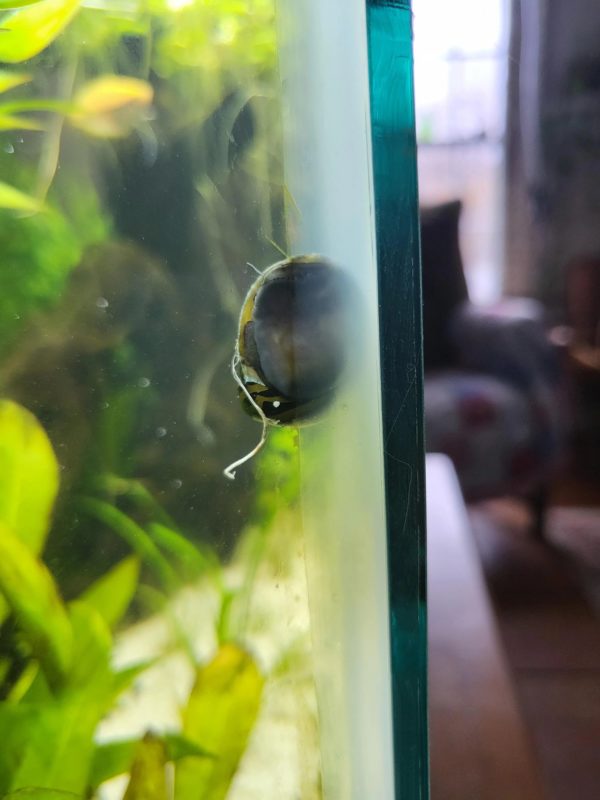
Missing Antennas
One common problem in zebra snails is missing antennas. It mainly happens when snails share the tank with nippy or aggressive fish.
If you notice that your snail does not have an antenna or if it’s broken, keep it in a separate tank. Give it some time, and its antenna will grow back.
Stunted Shell Growth
At certain times, the shell of zebra snails can stop growing. It mainly happens when the water temperature is too low or when the snail is not fed properly.
Shell Deterioration
Certain times, zebra snails can develop cracks and holes in their shells. In young zebra snails, this problem is seen due to soft and acidic water.
You can fix this issue by having a well-balanced pH level in the water. This way, the water will not erode the shell. Besides this, you can also feed broccoli or spinach.
This problem is seen in older zebra snails, probably due to age. When a snail reaches the end of its life, the shell deteriorates.
Growth Deformities
Often, zebra snails can develop growth deformities. In this situation, their shell grows slower than their body. It can expose the snails underneath the body, getting them injured.
Facts About Zebra Snails
- Most snails reproduce asexually, but this is not the case with zebra snails. Here, the female will lay an egg, and the male will fertilize it.
- Female snails can lay 20 to 50 eggs.
- Zebra snails can sleep for 15 hours or longer at a time.
Are Zebra Snails Right for You?
Zebra snails are among the best snail species to be kept in the tank as they do not have many maintenance requirements. With minimum maintenance, you can keep your snail happy. So, it’s not wrong to say that zebra snails are right for you.
FAQ
Are zebra snails good for tanks?
Zebra snails are good for tanks. They are sold as freshwater snails as they have a reputation for being outstanding tank cleaners. They are the most skillful algae eaters. While they have an appetite for green stuff, they do not eat plants. This thing makes them a great addition to the planted aquarium.
How many babies does a zebra snail have?
Initially, the eggs of zebra snails look like white ovals. It has a similar resemblance to that of sesame seeds. These white sesame-like bumps are not eggs; they are capsules. These capsules can hold between 30 to 100 of the actual eggs.
How to tell if the zebra snail is dead?
When a snail dies, its body shrinks, making the shell look dull. Also, the snail’s body will no longer be in the shell. It will hang out. Also, the shell will have a foul and rotten smell.
Do zebra snails hibernate?
If left in the wild, the freshwater zebra snails will hibernate by entering a deep sleep during winter. They will not come out until the water temperature rises again in the spring. But when kept in aquarium tanks, they are less likely to hibernate because the tank has a maintained water temperature.
The bottom line
The bottom line is that Zebra Snail is one perfect aquarium addition if you want something to help you get rid of algae there. Apart from the snail’s ability to eat algae, it also looks so beautiful and will add some oomph to your otherwise dull tank. The snails are native to the African continent and are most commonly found in Kenya, Tanzania, South Africa, and even Somalia.
No related posts.
